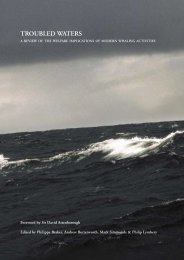Proceedings of the Untangled symposium: - WSPA
Proceedings of the Untangled symposium: - WSPA
Proceedings of the Untangled symposium: - WSPA
You also want an ePaper? Increase the reach of your titles
YUMPU automatically turns print PDFs into web optimized ePapers that Google loves.
Annex 4Submitted abstracts accompanyingposter presentationsLarge whale entanglement in marine debris:what do we know and what can be done?David MattilaTechnical adviser ‐ International Whaling Commission343 Bradford St., Provincetown, MA, USA 02657David.Mattila@IWC.intEntanglement in man-made ropes and net is consideredto be one <strong>of</strong> <strong>the</strong> single greatest human threats to manylarge whale populations. It has been estimated thatapproximately 308,000 whales, dolphins and porpoisesglobally die from entanglement in fishing gear each year(Read et al., 2006). How many more become entangledin derelict gear and marine debris is not known. However,it has been estimated that in some areas “ghost fishing”by derelict fishing gear may represent 30% <strong>of</strong> <strong>the</strong>total “catch” <strong>of</strong> <strong>the</strong> target species (Laist, D. W., 1996).Therefore, it is reasonable to assume that bycatch <strong>of</strong>cetaceans by derelict gear may also approach 30% <strong>of</strong>that estimated for actively fished gear in some areas(Mattila and Lyman, 2006). In addition, derelict gear maydrift to o<strong>the</strong>r regions, joining o<strong>the</strong>r types <strong>of</strong> manmaderopes and net, creating an entanglement problem ina region with no known “high risk” active fishing (e.g.Central North Pacific). One <strong>of</strong> <strong>the</strong> ways to understand<strong>the</strong> relative risk <strong>of</strong> large whale entanglement in derelictfishing gear and marine debris is to remove and fullydocument <strong>the</strong> gear on <strong>the</strong> whale, and <strong>the</strong>n trace it backto its origin, if possible. A formal whale disentanglementnetwork was established in Hawaii in 2002, and itcurrently uses internationally recognized tools andtechniques to safely remove manmade materials fromlarge whales. The principles and guidelines used weredeveloped through consensus by representatives from allcurrent national whale disentanglement programs, andsubsequently endorsed by <strong>the</strong> 89 member countries <strong>of</strong><strong>the</strong> International Whaling Commission. Gear removedfrom entangled whales in Hawaii using <strong>the</strong>se techniques,has come from several sources, including gear fishedin Alaska (2,500 nm away) and marine debris. The IWCinitiative to expand this research and mitigation effortusing <strong>the</strong> strategy and curriculum developed by its expertadvisory panel is discussed.Entangled and fish-hooked seals, stranded in <strong>the</strong>Ne<strong>the</strong>rlands during <strong>the</strong> period 1985-2010D.W. van Liere, R. Hekman & N. OsingaSeal Rehabilitation and Research CentreHo<strong>of</strong>dstraat 94a, 9968 AG, Pieterburen, The Ne<strong>the</strong>rlandsdiederik@zeehondencreche.nlThe Seal Rehabilitation and Research Centre Lenie ’tHart rehabilitates orphaned, sick or injured seals. Theseare mostly common seals (Phoca vitulina) and grey seals(Halichoerus grypus) stranded along <strong>the</strong> coast <strong>of</strong> <strong>the</strong>Ne<strong>the</strong>rlands. All cases, including dead stranded seals,are recorded in a database. The centre currently treats/rescues between 400 and 700 common seals and 50 to150 grey seals stranded per year.For <strong>the</strong> period 1985-2010, <strong>the</strong>re were 54 entangledseals, <strong>of</strong> which 89% stranded in <strong>the</strong> last ten years (2001- 2010). Entanglements were recorded significantlymore <strong>of</strong>ten for grey seals (n=39) than for common seals(n=15). All entanglements were around <strong>the</strong> neck andhead. In some animals, o<strong>the</strong>r parts <strong>of</strong> <strong>the</strong> body, mostly<strong>the</strong> front flippers, were also entangled. Traumatic injuries<strong>of</strong> <strong>the</strong> skin or blubber layer, up to muscles (lacerationsand penetrating wounds), were common as a result <strong>of</strong>net entanglement. In most cases, secondary infectionsdeveloped as a result <strong>of</strong> wound contamination. Admittedseals manifested pain and stressed behavior. Usuallyentangled seals were in poor body condition whencaught. After removal <strong>of</strong> <strong>the</strong> net, <strong>the</strong> lesions werecleaned, and disinfected. The seals were given accessto a pool with salt water, and <strong>the</strong> lesion usually healedwithin several weeks. After healing <strong>of</strong> <strong>the</strong> wound, anindentation around <strong>the</strong> neck was still visible in mostcases. Seals were released once <strong>the</strong>y had gainedsufficient weight.For 31 seals, <strong>the</strong> type <strong>of</strong> net could be identified: 18 weretrawl nets and 13 were gillnets. Trawl net mesh sizevaried between 10 and 20 cm. Weights varied between500 and 1500 gram, with <strong>the</strong> exception <strong>of</strong> one trawl netthat weighed 11 kilogram. Mesh size <strong>of</strong> <strong>the</strong> gillnets variedbetween 9 and 26 cm and weights were between 1-500gram. One <strong>of</strong> <strong>the</strong> gillnets had three filaments twistedtoge<strong>the</strong>r, all o<strong>the</strong>rs were mon<strong>of</strong>ilament.54
















